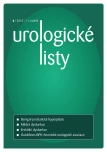„Steal syndrom“ penilní arterie: případová studie a přehled literatury
Case presentatiom of penile artery steal syndrome and literature review
Penile revascularization is a re-emerging surgical approach ideally suited for young patients with isolated traumatic vasculogenic erectile dysfunction (ED) and no risk factors. We reviewed the literature on penile revascularization and present the interesting case of a 27-year-old man with severe organic ED attributed to a fall onto his back at age 14. Diagnostic work-up revealed severe insufficiency of the left cavernosal artery, with no evidence of venous leak. The patient underwent operative penile revascularization with documented patent anastomosis according to penile duplex Doppler ultrasound, but his ED continued post-operatively. Subsequent arteriography was performed and revealed a left-sided steal phenomenon due to an aberrant obturator artery arising from the donor inferior epigastric artery. The patient underwent successful embolization of the obturator artery, with resolution of the steal and improvement in erectile function. We report this case as Penile Artery Steal Syndrome (PASS), an iatrogenic cause of ED attributable to revascularization in the setting of anomalous vasculature.
Key words:
penile artery steal syndrome (PASS), microarterial bypass, erectile dysfunction, embolization, pelvic steal syndrome
Autoři:
J. G. Pavlinec; T. S. Hakky; J. Emtage; D. Martinez; R. Simon; J. Parker; R. Munarriz; K. Massis; R. E. Carrion
Vyšlo v časopise:
Urol List 2013; 11(4): 18-24
Souhrn
Revaskularizace cévního řečiště penisu je ideální operační technikou pro léčbu mladých pacientů s izolovanou erektilní dysfunkcí (ED) traumatické vaskulogenní etiologie bez jakýchkoli rizikových faktorů. V tomto článku hodnotíme publikace zabývající se technikami penilní revaskularizace a prezentujeme zajímavý případ 27letého muže se závažnou organickou ED, jejíž příčinu lze připisovat pádu na záda ve 14 letech. Diagnostické vyšetření prokázalo závažnou insuficienci levé kavernózní arterie, bez známek žilního úniku. Pacient podstoupil penilní revaskularizaci a ačkoli dopplerovské ultrazvukové vyšetření prokázalo průchodnou anastomózu, ED po výkonu přetrvala. Arteriografie odhalila přítomnost tzv. „steal syndromu“ na levé straně v důsledku aberantní obturátorové arterie, odstupující z dárcovské dolní epigastrické arterie. Pacient podstoupil úspěšnou embolizaci obturátorové arterie, která vedla k vyřešení steal syndromu a ke zlepšení erektilní funkce. Klasifikujeme tento případ jako steal syndrom penilní arterie (PASS); jedná se o iatrogenní příčinu ED, způsobenou pravděpodobně revaskularizační operací v kontextu aberantní vaskulatury.
Klíčová slova:
„steal syndrom“ penilní arterie (PASS), mikroarteriální bypass, erektilní dysfunkce, embolizace, pánevní „steal syndrom“
Zdroje
1. NIH Consensus Conference. Impotence. NIH Consensus Development Panel on Impotence. JAMA 1993; 270(1): 83–90.
2. Aytac IA, McKinlay JB, Krane RJ. The likely worldwide increase in erectile dysfunction between 1995 and 2025 and some possible policy consequences. BJU Int 1999; 84 : 50–56.
3. Feldman HA, Goldstein I, Hatzichristou DG et al. Impotence and its medical and psychosocial correlates: results of the Massachusetts Male Aging Study. J Urol 1994; 151(1): 54–61.
4. Capogrosso P, Colicchia M, Ventimiglia E et al. One patient out of four with newly diagnosed erectile dysfunction is a young man-worrisome picture from the everyday clinical practice. J Sex Med 2013; 10(7): 1833–1841.
5. Huang V, Munarriz R, Goldstein I. Bicycle riding and erectile dysfunction: an increase in interest (and concern). J Sex Med 2005; 2(5): 596–604.
6. Dicks B, Bastuba M, Goldstein I. Penile revascularization – contemporary update. Asian J Androl 2013; 15(1): 5–9.
7. Montorsi F, Adaikan G, Becher E et al. Summary of the recommendations on sexual dysfunctions in men. J Sex Med 2010; 7(11): 3572–3588.
8. Michal V, Kramár R, Pospíchal J et al. Vascular surgery in the treatment of impotence; its present possibilities and prospects. Czech Med 1980; 3(3): 213–217.
9. Rowe C, Ganick S, Munarriz R. Traumatic vasculogenic erectile dysfunction: role of penile microarterial bypass surgery. Curr Urol Rep 2010; 11(6): 427–431.
10. Sharlip ID. Penile revascularization in the treatment of impotence. West J Med 1981; 134(3): 206–11.
11. Michal V, Kramár R, Pospíchal J et al. Direct arterial anastomosis on corpora cavernosa penis in the therapy of erective impotence. Rozhl Chir 1973; 52(9): 587–590.
12. Austoni E, Colombo F. Impotence from the 70‘s through the 90‘s: 20 years of evolution of diagnosis and therapy. Arch Ital Urol Nefrol Androl 1992; 64(3): 231–237.
13. Hauri D. Penile revascularization surgery in erectile dysfunction. Urol Int 2003; 70(2): 132–140.
14. Munarriz R, Uberoi J, Fantini G et al. Microvascular arterial bypass surgery: long-term outcomes using validated instruments. J Urol 2009; 182(2): 643–648.
15. Hauri D. Penile revascularization surgery in erectile dysfunction. Andrologia 1999; 31 (Suppl 1): 65–76.
16. Yildirim D, Bozkurt IH, Gurses B et al. A new parameter in the diagnosis of vascular erectile dysfunction with penile Doppler ultrasound: cavernous artery ondulation index. Eur Rev Med Pharmacol Sci 2013; 17(10): 1382–1388.
17. Virag R, Bennett AH. Arterial and venous surgery for vasculogenic impotence: a combined French and American experience. Arch Ital Urol Nefrol Androl 1991; 63(1): 95–100.
18. Lund GO, Winfield HN, Donovan JF. Laparoscopically assisted penile revascularization for vasculogenic impotence. J Urol 1995; 153(6): 1923–1926.
19. Kawanishi Y, Kimura K, Nakanishi R et al. A minimally invasive method for harvesting the epigastric artery for penile revascularization. BJU Int 2004; 94(9): 1391–1396.
20. Raynor MC, Davis R, Hellstrom WJ. Robot-assisted vessel harvesting for penile revascularization. J Sex Med 2010; 7(1 Pt 1): 293–297.
21. Sohn M, Hatzi
Štítky
Dětská urologie UrologieČlánek vyšel v časopise
Urologické listy

2013 Číslo 4
- Společně – a neinvazivně – proti inkontinenci a chronickým zánětům pochvy
- Prevence opakovaných infekcí močových cest s využitím přípravku Uro-Vaxom
- Zápach při inkontinenci je častou obavou pacientů
- Aktuální doporučení EAU pro léčbu nekomplikovaných cystitid
- Význam monitorování hladiny anti-Xa u pacientů užívajících profylaktické dávky enoxaparinu − série kazuistik
Nejčtenější v tomto čísle
- Objemný angiomyolipom pravé ledviny u mladé ženy
- Současné postupy při rehabilitaci penisu
- Předčasná ejakulace – diagnostika a moderní léčba
- Botulotoxin: proč jej užívat, jak na to a jaké jsou výsledky?

